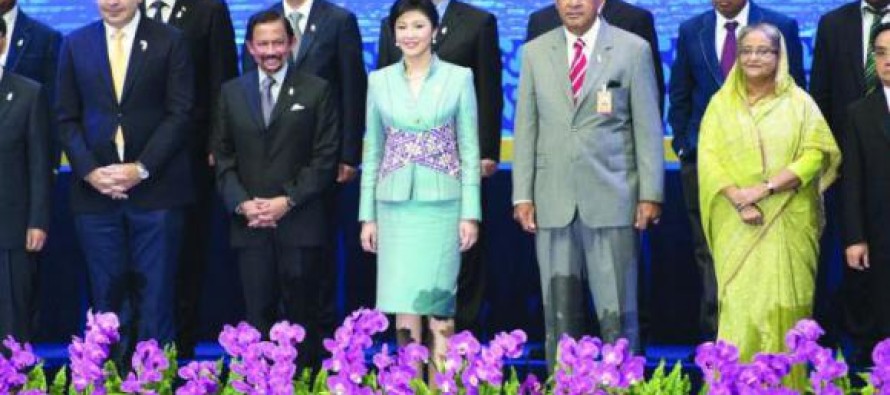Asia-Pacific Water Summit Bangladesh

Bangladesh Prime Minister Sheikh left for Chiang Mai on 19th May 20, 2013 for a three-day visit to participate in the 2nd Asia-Pacific Summit.
It is reported tahat at the summit Bangladeshi Prime Minister Sheikh Hasina cited a water-sharing treaty between her nation and India over the Ganges river as an example of successful water diplomacy .“Only judicious management of access to water resources” will prevent conflict, she said, adding that low-lying Bangladesh has around 30 million people exposed to rising sea levels.
State of Rivers in Bangladesh:
Rivers are Bangladesh’s arteries of life and the life style of the people of Bangladesh has developed depending on rivers. It is reported in media that 80 rivers are about to die out in Bangladesh, while 100 have lost their natural characteristics due to various reasons.
Being located at the mouths of three major rivers- the Ganges, Brahmaputra and Meghna (GBM), the country has one of the largest deltas in the world.
One of the characteristics of the Ganges, Brahmaputra and Meghna are that they are both snow-fed and rain-fed. That is why water remains in the rivers during the dry and wet seasons. According to a report of the UN Environment Programme, global warming would melt glaciers in various parts of the world including those in the Himalayas. This will have less snow-fed waters for the GBM.
Bangladesh’s need for water:
Bangladesh will need to increase its agricultural yield about 2% per cent per year to meet the needs of the population that will increase to 200 million by 2020. Irrigating crops in the country reportedly accounts for 70% per cent of all the water use. For example, it takes 1,000 tons of water to grow one ton of wheat, 2000 tons to produce one ton of rice. Industries need water and their products bring millions of dollars to the economy.
The UNESCO-sponsored World Water Development Report, published in March 2003, indicated that by the middle of this century, more than 60 countries including Bangladesh are likely to face acute shortage of fresh water.
Food and energy production depend on the availability of water. Power plants whether nuclear or conventional require large quantities of water to cool their exhaust streams.
Furthermore underground water source will be gradually depleted as 69% per cent of Bangladesh’s water reportedly comes from below ground. For Dhaka city itself, it relies on underground water reserves. There are 1300 bore- holes tapping water below Dhaka and it is reported that in some areas the water table has fallen more than 40 metres.
Already media has been replete with news of acute shortage of fresh water in Dhaka city and around. As the demand for water increases, share of water per person will decrease greatly. With the increase of population in the coming years from 14 million to 30 million by 2020, it may become a huge problem for the inhabitants of the capital city,
Although water is the commonest stuff on earth, experts say that only 2.53 per cent of it is fresh, while the rest is salt- water (sea water).
And of the fresh water, two thirds is locked up in glaciers and permanent snow cover. What is available is one-third of fresh water in lakes, rivers, aquifers (ground water) and rainfall.
Factors reducing fresh water:
Population growth, (ii) pollution and (iii) climate change will combine to produce a drastic decline in water supply in the years ahead.
First, population is now about 7 billion in the world and in the next 25 years there will be 2 billion more people coming onto the earth and virtually all of that will go to developing countries.
It has been reported that between 1970 and 1990, available per capita water supply decreased by one third. Demand comes not just from the need to drink, the need to wash, and the need to deal with human waste, the large demand comes from industry and agriculture in the developing world.
Second, pollution is another pressure point. With one litre of waste- water sufficient to pollute about eight litres of fresh water. Pollution comes from industry, agriculture and human generated wastes. About million tons of wastes are dumped every day into rivers, lakes and streams,
Third, climate change will account for 20% per cent of the decline through erratic rainfall and a rise in the sea level. Climate change is also responsible for saline water creeping inside land and rivers.
Fourth, underground water is diminishing rapidly. It has been reported that across Asia, Africa and Latin America, ground water level are dropping as much as 3 metres a year.
Regional Cooperation:
Regional cooperation on water management on shared river basins is imperative. For example, the Mekong River Commission (MRC) established in 1995 with Cambodia, Vietnam and Laos together with China and Myanmar as dialogue partners in 1996 has the mandate of cooperation in flood control, hydropower, irrigation and fisheries among others to optimise use for benefits of shared-basin countries.
It is suggested that Basin-wise Commissions (one for the Ganges and the other for Brahmaputra basins) be constituted with all countries who share the basin as members, for water- sharing and water resources- management including flood control and irrigation for the benefit of the people of the region.
Conclusion:
Since fresh water is distributed unevenly around the world, water issue could be a political “time bomb”. As demand for fresh water increases conflict of interest will arises between upper and lower riparian countries. Some water experts say that water scarcity may lead to even armed conflicts in the next few decades.
Finally, where there is water, there is life, energy, and well-being. Water is a right to every one.. Without it human beings could not live and it is the duty of all governments that water is available to everyone.
By Barrister Harun ur Rashid
Former Bangladesh Ambassador to the UN, Geneva


